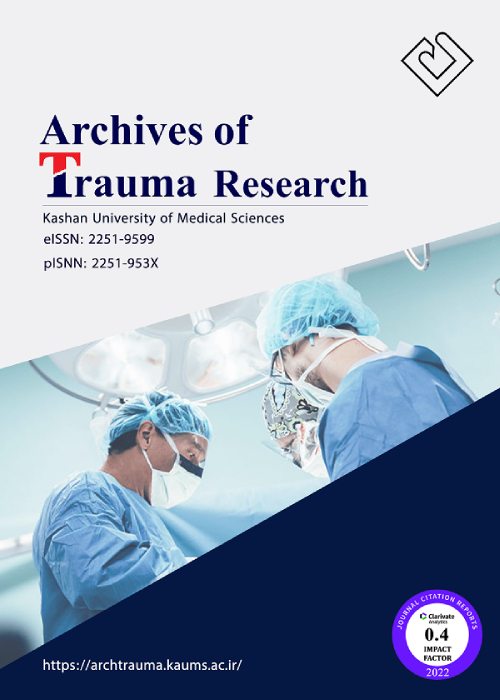An evaluation of trauma scores (RTS, GAP, EMTRAS) on mortality in multiple trauma patients
Author(s):
Article Type:
Research/Original Article (دارای رتبه معتبر)
Abstract:
Background
Emergency Trauma Score (EMTRAS), Revised Trauma Score (RTS) and Glasgow Age Pressure (GAP) are used to determine the patient status, and to predict the intervention and prognosis.Objectives
The aim of the present study was to evaluate the association between mortality and trauma severity scores (EMTRAS, RTS, and GAP) in multiple trauma patients.Methods
In this study, patients who had referred to the Emergency Department of Mustafa Kemal University Hospital due to multiple trauma within a one-year period were evaluated retrospectively. The hospital is located in the central district of Hatay, Antakya in the Republic of Turkey, 680 km from the capital, on the Syrian border. Its population is 1,5 million. Antakya is located as the central district of Hatay with population of 400,000. Demographic data, trauma type, nationality, vital parameters [pulse, peripheral oxygen saturation (SO2), respiratory count, systolic blood pressure (SBP), diastolic blood pressure (DBP)], physiological scoring systems (GCS, RTS, GAP and EMTRAS), and mortality states of the patients were reviewed. Data were analysed by SPSS 21, and the effect of current parameters on short-term (in the emergency service) and long-term (30 days) mortality was examined.Results
Three hundred and thirty-three multi-trauma patients were enrolled into the study. The median age of the patients was 31 (IQR: 22) years; 88.3% (294) of the patients were male. The exitus rate was detected as 7.8% in the emergency service and 26.4% within one month. GCS, RTS and GAP values of the patients who have died in the emergency service and within one month were significantly lower; however, the EMTRAS level was significantly higher in these patients (p<0.05). RTS and EMTRAS were detected as short- and long-term independent variables for mortality (p<0.05). After Receiver Operating Characteristic (ROC) analysis, the areas under the curve (AUC) of GCS, GAP, RTS and EMTRAS for short-term mortality were 0.861cm2, 0.876 cm2, 0.901cm2 and 0,917cm2, respectively; the AUC of such parameters for long-term mortality was detected 0.896cm2, 0.904 cm2, 0.914cm2and 0.899cm2, respectively.Conclusion
EMTRAS values were detected more significant parameters for short-term mortality whereas RTS was more significant for long-term mortality in multiple trauma patients. Such two scores may be useful to predict the patient prognosis along with GCS or solely.Keywords:
Multiple Trauma , RTS , gap , EMTRAS , mortality
Language:
English
Published:
Archives of Trauma Research, Volume:12 Issue: 2, Apr-Jun 2023
Pages:
63 to 70
magiran.com/p2675582
دانلود و مطالعه متن این مقاله با یکی از روشهای زیر امکان پذیر است:
اشتراک شخصی
با عضویت و پرداخت آنلاین حق اشتراک یکساله به مبلغ 1,390,000ريال میتوانید 70 عنوان مطلب دانلود کنید!
اشتراک سازمانی
به کتابخانه دانشگاه یا محل کار خود پیشنهاد کنید تا اشتراک سازمانی این پایگاه را برای دسترسی نامحدود همه کاربران به متن مطالب تهیه نمایند!
توجه!
- حق عضویت دریافتی صرف حمایت از نشریات عضو و نگهداری، تکمیل و توسعه مگیران میشود.
- پرداخت حق اشتراک و دانلود مقالات اجازه بازنشر آن در سایر رسانههای چاپی و دیجیتال را به کاربر نمیدهد.
In order to view content subscription is required
Personal subscription
Subscribe magiran.com for 70 € euros via PayPal and download 70 articles during a year.
Organization subscription
Please contact us to subscribe your university or library for unlimited access!


